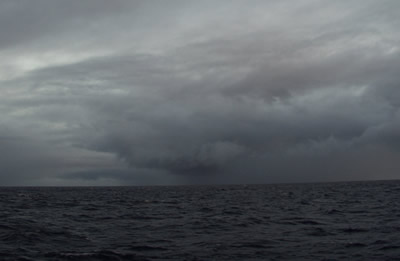This image shows a fog bank in a valley of the Atacama Desert, along the coast of northern Chile. These fog banks are called "las camanchacas."
Click on image for full size
Image Courtesy of Darryl Scott
Extreme Weather in the Southeast Pacific
The weather in the Southeast Pacific region is thought of as extreme, because it receives very little rain and is extremely dry. For example, some places in the Atacama Desert in Chile receive less than one millimeter (0.04 inches) of rain a year.
There are several reasons why this region is so dry. The Chilean Coastal Range and the Andes mountains block this area from receiving moisture. In addition, a large wind current called the Pacific Anticyclone blows dry air into the region. Finally, an ocean current called the Humboldt Current brings cool water up the coast of Chile. The ocean current cools the air above it and forms clouds that usually don't produce precipitation.
Over the Southeast Pacific Ocean the clouds do produce drizzle, but this doesn't usually happen over the land. Instead, fog sometimes forms along the coast. People who live in this region call this fog "camanchacas." It is important to support life. Even though it doesn't actually rain, algae, lichen, and some cacti are able to capture enough moisture from the fog in order to survive. People use nets to capture water from the fog.
You might also be interested in:

Raindrops form when tiny water droplets collide together in clouds to form bigger ones. When they get too heavy, rain falls out of the clouds. Rain is more than 5mm in diameter. The types of clouds that
...more
This page describes environments that are very hot or very cold, really dry, or both. It is easy for living creatures to survive and grow in some places. Other places make it tough for life to get by.
...more
The Atacama Desert is one of the driest places on Earth. The Atacama is in the country of Chile in South America. In an average year, this desert gets less than 1 millimeter (0.04 inch) of rain! It is
...more
The winds in the Southeast Pacific mainly blow from south to north. They affect the weather and climate in the region. They also affect the climate in other places around the world. Air near the equator
...more
The water at the ocean surface is moved by powerful wind. The wind is able to move the top 400 meters of the ocean. This moving water is called surface ocean currents. Surface ocean currents form large
...more
A cloud is composed of tiny water droplets or ice crystals. A series of things have to happen in order for these water droplets or ice crystals to form into clouds in the atmosphere, and different types
...more
Drizzle is very light rain; the water drops that make up drizzle are smaller than rain drops. Drizzle can be so light that only a millimeter of water falls to the Earth's surface in one day. It is produced
...more















